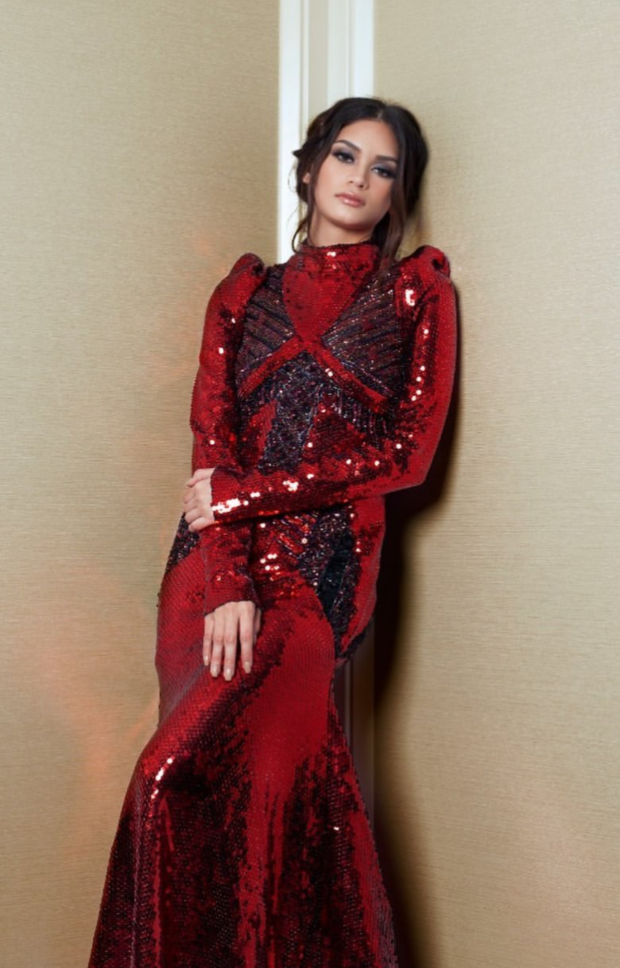
Social media had a field day Wednesday when London-based fashion designer Lesley Mobo posted on Facebook a screen shot of a sequined red dress from his 2015 Red Charity Gala collection that had been missing from his archive.
It was from the Instagram of beauty queen Gazini Ganados. Everyone—photographer, stylist, hairstylist and makeup artist—was credited in the Binibining Pilipinas Universe 2019’s Instagram post but Mobo.
In his post, the designer wondered how he could get the dress back, even buy it if he had to.
Shortly after, Mobo posted another screen shot, which, he wrote, had been forwarded by a friend. It was the same dress posted in Vestido Manila, a Manila-based rental website, co-owned by Pam Quiñones, the stylist credited in Ganados’ photo. (As of press time, the Mobo dress is no longer on the site.)
Mobo later took down both posts. He wrote in a subsequent post Thursday that he didn’t want to ruin the stylist’s reputation, but was, however, incensed when another individual was trying, obliquely, to defend what Mobo considered theft.
“If u think that stealing is right then you have to really question your moral values BIG TIME mate! What u are doing is false loyalty,” Mobo wrote.
“I’m over the missing dress,” Mobo told Lifestyle. What he was mad at, he said, was a certain individual who “keeps stirring the situation” with “life quotes” that seemed to defend the stylist. “There’s a time to just shut up and accept that it’s wrong,” he said of the person he was alluding to.
Luggage
Mobo recalled that Quiñones borrowed his Red Charity Gala collection in 2015 for a photo shoot for L’Officiel Manila, the now-defunct magazine edited by the stylist. He himself had picked up the luggage containing the clothes from Quiñones’ place after the shoot.
Going over the contents of the luggage, he discovered that one dress was missing and texted Quiñones. She said it was all there. “That’s how we left it,” he said.
After his posts exploded on Facebook, Quiñones messaged Mobo to apologize and offered to return the dress, which the designer accepted. “She said sorry, that’s all I need.”
Mobo said Quiñones claimed she borrowed it for a celebrity client but it was never used and that when she tried to return it, that Mobo told her to “keep it na lang muna.” Quiñones, according to Mobo, texted him: “I thought it was ‘mine’ na after four years kasi.”
“I never gave it to her,” Mobo said. “I would have gladly given it had she asked, no questions. But no. So there’s no misunderstanding there.”
(Quiñones didn’t reply to Lifestyle’s request for comment.)
However, Mobo doesn’t want to cause the stylist any harm. “It’s her living and her career. She’s talented. I know how hard it is to make a living in fashion. I think I’ve made my point and that’s enough.”
Mobo’s story isn’t unique. Designers, especially new ones who are desperate to get exposure, are often victimized by errant stylists, who either make false promises or, worse, never return the borrowed clothes (pullouts, in industry parlance). Or, if the clothes are returned at all, they’re badly damaged.
Mobo received multiple messages from other designers eager to share their own horror stories with stylists, he told us. An unlikely caller was Dubai-based Michael Cinco, who told him of his own experiences with Manila stylists.
Cinco told Lifestyle that another popular stylist borrowed a dress from him for a local star’s concert five years ago. Cinco had to custom-make the dress and even paid for the shipment.
The stylist never returned it. Cinco never worked with that stylist again until recently —and only because it was the stylist’s actress-client who contacted him directly.
Victimized
Designers, especially upstarts, often fall prey because they’re eager to see their clothes worn by celebrities and hopefully get clients that way, said Cinco. In his efforts to break into the Hollywood circuit, Cinco himself had been victimized by stylists who borrowed couture pieces for stars that were never returned.
“You put in a lot of time, money and effort into creating a couture piece that you will never see again. You have to ask yourself, is it worth it?” Cinco said.
“Designers rely on stylists for exposure, but it should be give and take. They should take responsibility for the borrowed clothes. When we hand over the dresses, they’re packed with care and respect.”
Like Mobo, Cinco doesn’t make stylists sign a borrower’s contract because “it’s all about trust.” The arrangement between designer and stylist is often informal.
Cinco said he has learned his lesson, so that now he demands a return plane ticket for his staff whenever a dress is borrowed. “I never ask for money, only a plane ticket, so that my assistant can take back the dress right after the event.”
Cinco cited an incident at the Cannes film festival where a star’s stylist returned his couture piece in a sorry state. “I was so mad I told the stylist and the celebrity to return it in a proper way or I’ll post a picture of it on social media and make them pay. Natakot.”
Cinco was also mortified that Mobo’s dress was being profited from—it was being rented out “for P7,000 and selling for P22,000,” a tag that he saw as a huge devaluation of the Londoner’s brand.
“One of the guys I’ve been mentoring is also a victim,” Mobo said. “They’re so scared of the stylists that he erased all traces of our conversation. I hope they can stop victimizing young designers.”
Another noted designer told Mobo of how he discovered one of his dresses in the storage area of a fashion glossy; the magazine borrowed the dress for a shoot years ago when he was a newbie, and never returned it.
But if such could happen to someone of Mobo’s and Cinco’s stature, what’s to stop unscrupulous entities from doing the same to industry novices? —CHECHE V. MORAL